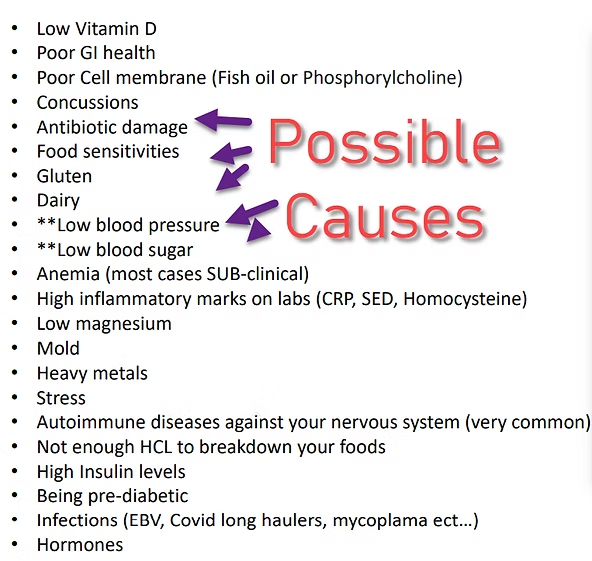Dysautonomia symptoms & treatment
I have personally helped hundreds of people with dysautonomia. Many people go from doctor to doctor trying to find what is causing their neurological problems and end up being given anti-anxiety or antidepressant medications to no avail.
So what is dysautonomia?
According to the organization, Dysautonomia International, dysautonomia describes several medical conditions causing a malfunction of the Autonomic Nervous System. This part of the nervous system is what controls the body functions our bodies do without us thinking about it. This can include heart rate, blood pressure, pupils, kidney function, etc.
Because this condition affects your brain’s ability to automatically perform tasks, you might see symptoms from any organ or system that you do not consciously need to regulate. The problem is in your brain but shows symptoms in your organs and systems, including your:
- Heart
- Blood vessels
- Kidneys
- Spleen
- Skin
- Stomach
- Bladder
- Pancreas
- Lungs
- Gallbladder
- Small and/or large intestines
- Eyes
- Immune system
Since the symptoms are caused by neurological issues but expressed in other symptoms, it can be extremely difficult to diagnose dysautonomia as the cause.
THIS IS WHAT YOU WANT SLOW!

You DON’T want FAST

- Rapid heart rate
- Orthostatic hypertension (sudden rise in blood pressure when standing)
- Chronic fatigue
- Anxiety
- Temperature regulation
- Shortness of breath
- Irritable bowel syndrome
- Dizziness
- Migraines
Dysautonomia, the Midbrain, and the Cerebellum
The central portion of the brain, aptly called the midbrain, is what controls these automatic regulations. If it is not functioning properly, you will likely be experiencing neurological issues that you (and likely your doctors) do not understand.
Similar to the midbrain, the cerebellum is directly connected to your body through the spinal cord. The cerebellum alone has more neurons than the rest of your entire brain combined and acts as a sort of “gatekeeper” between the brain and the body. It regulates the signals and information being passed both ways.
The cerebellum is directly connected to the rest of the body through the spinal cord and nerves. If there is something wrong with the cerebellum, it will have immediate effects on the rest of the body.
This takes the form of problems caused within your parasympathetic and sympathetic nerve systems. The former controls functions related to relaxation and digestion, while the latter is related to your “fight or flight” responses. Dysautonomia often causes problems by activating your sympathetic systems.
What Causes Dysautonomia?
I can confidently say that 100% of the clients I work with have some level of dysautonomia. The causes can be minor or major, including:
- Low Vitamin D levels
- Poor GI health
- Poor cell membrane function
- Concussions
- Antibiotic damage
- Food sensitivities (including dairy and gluten)
- Low blood pressure
- Low blood sugar
- Anemia
- High inflammatory marks on labs
- Low magnesium levels
- Mold infection
- Heavy metals present in the body
- Stress
- Autoimmune diseases against your own nervous system
- Not enough stomach acid to properly digest food
- High insulin levels
- Being pre-diabetic
- Major infections (EBV, long-haul covid, etc)
Examples of Dysautonomia
While there are many ways these causes may present themselves, here is a simple example of how dysautonomia might be affecting your body.
Let’s say your stomach is not using enough acid to break down food. This keeps the food in your system longer, which allows it to ferment. This fermentation brings with it higher bacteria growth than is necessary. That higher level of bacteria results in more protein being passed into the blood, which can create major inflammation problems throughout the entire body.
Your nervous system is an “all or nothing” system. That means it either is firing completely, or not at all. Dysautonomia lowers your threshold for your nerves to fire, meaning that less stimuli is needed for your brain to act. An example of this might be light or noise sensitivity.
Things to get checked out
What Can You Do?
The first thing to do is get tested and look for the root causes listed above. Finding out what problems are going on in your body will give you a clear idea of how to approach your treatment.
Finding out you suffer from chronic low blood pressure, or subclinical anemia will help you treat your individual problems and allow your body to function properly.
Not all situations require testing. For example, if you consistently suffer from bloating, diarrhea, or other digestive problems then you can likely ascribe your dysautonomia to a GI issue without testing.
You can look for resources on my website or schedule a call with me, and we can discuss what issues you are experiencing. Together we can come up with a treatment plan that can help you on the way to health.
Research citations for further reading
All that shakes is not epilepsy.
Hart YM. J R Coll Physicians Edinb. 2012 Jun; 42(2):151-4.
Amnesia for loss of consciousness is common in vasovagal syncope.
O’Dwyer C, et al. Europace. 2011 Jul; 13(7):1040-5.
Aortic elastic properties of patients with neurocardiogenic syncope.
Sucu MM, et al. Pacing Clin Electrophysiol. 2009 Nov; 32(11):1417-21.
Are treatments for vasovagal syncope effective? A meta-analysis.
Vyas A, et al. Int J Cardiol. 2012 May. [Epub ahead of print]
Arterial baroreflex function in older adults with neurocardiogenic syncope.
Madden KM, Lockhart C. Clin Invest Med. 2009 Jun; 32(3):E191-8.
Basic autonomic nervous function in patients with neurocardiogenic syncope.
Saito F, et al. Clin Exp Hypertens. 2007 Apr; 29(3):165-73.
Cardiac autonomic disturbances in patients with vasovagal syndrome: comparison between iodine-123-metaiodobenzylguanidine myocardial scintigraphy and heart rate variability.
Kochiadakis G, et al. Europace. 2012 Mar. [Epub ahead of print]
Cardioinhibitory carotid sinus hypersensitivity predicts an asystolic mechanism of spontaneous neurally mediated syncope.
Maggi R, et al. Europace. 2007 Aug; 9(8):563-7.
Catheter ablation of severe neurally meditated reflex (neurocardiogenic or vasovagal) syncope: cardioneuroablation long-term results.
Pachon JC, et al. Europace. 2011 Sep; 13(9):1231-42.
Cerebral blood flow abnormalities in patients with neurally mediated syncope.
Joo EY, et al. J Neurol. 2011 Mar; 258(3):366-72.
Clinical efficacy of beta1 selective adrenergic blockers in the treatment of neurocardiogenic syncope – a meta-analysis.
Vallurupalli S, Das S. Clin Pharmacol. 2010; 2:163-7.
Comparison of recurrence rate based on the frequency of preceding symptoms in patients with neurocardiogenic syncope or presyncope.
Lee SM, et al. Korean Circ J. 2011 Aug; 41(8):434-9.
Dysautonomia: Perioperative Implications.
Anesthesiology. 2012 Feb;116;1:205?215
Endogenous circadian rhythm in vasovagal response to head-up tilt.
Hu K, et al. Circulation. 2011 Mar; 123(9):961-70.
Enhanced vascular responses to hypocapnia in neurally mediated syncope.
Norcliffe-Kaufmann LJ, et al. Ann Neurol. 2008 Mar; 63(3):288-94.
Evaluation of syncope.
Gauer RL. Am Fam Physician. 2011 Sep; 84(6):640-50.
Genetic variation in gsα protein as a new indicator in screening test for vasovagal syncope.
Lelonek M, et al. Circ J. 2011; 75(9):2182-6.
Increased hydration alone does not improve orthostatic tolerance in patients with neurocardiogenic syncope.
Bellard E, et al. Clin Auton Res. 2007 Apr; 17(2):99-105.
Neurally-mediated syncope.
Can I, et al. Minerva Med. 2009 Aug; 100(4):275-92.
Neurocardiogenic syncope coexisting with postural orthostatic tachycardia syndrome in patients suffering from orthostatic intolerance: a combined form of autonomic dysfunction.
Kanjwal K, et al. Pacing Clin Electrophysiol. 2011 May; 34(5):549-54.
Pharmacotherapy of autonomic failure.
Shibao C, et al. Pharmacol Ther. 2012 Jun; 134(3):279-86.
Physiological phenomenology of neurally-mediated syncope with management implications.
Schroeder C, et al. PLoS One. 2011; 6(10):e26489.
Positive result in the early passive phase of the tilt-table test: a predictor of neurocardiogenic syncope in young men.
Uhm JS, et al. Korean J Intern Med. 2012 Mar; 27(1):60-5.
Recognition and management of complications during moderate and deep sedation. Part 2: cardiovascular considerations.
Becker DE, et al. Anesth Prog. 2011 Fall; 58(3):126-38.
Respiration drives phase synchronization between blood pressure and RR interval following loss of cardiovagal baroreflex during vasovagal syncope.
Ocon AJ, et al. Am J Physiol Heart Circ Physiol. 2011 Feb; 300(2):H527-40.
Symptoms and signs of syncope: a review of the link between physiology and clinical clues.
Wieling W, et al. Brain. 2009 Oct; 132(Pt 10):2630-42.
Syncopal migraine.
Curfman D, et al. Clin Auton Res. 2012 Feb; 22(1):17-23.
The changing face of orthostatic and neurocardiogenic syncope with age.
Cooke J, et al. QJM. 2011 Aug; 104(8):689-95.
The effect of paediatric syncope on health-related quality of life.
Anderson JB, et al. Cardiol Young. 2012 Feb. [Epub ahead of print]
The influence of vasovagal response on the coagulation system.
Kraemer M, et al. Clin Auton Res. 2010 Apr; 20(2):105-11.
The origin of vasovagal syncope: to protect the heart or to escape predation?
Alboni P, et al. Clin Auton Res. 2008 Aug; 18(4):170-8.
Therapy of vasovagal syncope: to prevent the vasovagal reflex or to treat the impending reflex?
Alboni P. Europace. 2010 Jun; 12(6):776-8.
Vasovagal syncope and vasovagal disease.
Brignole M. Hellenic J Cardiol. 2008 Mar; 49(2):61-4.
Vulnerability to simple faints is predicted by regional differences in brain anatomy.
Beacher FD, et al. Neuroimage. 2009 Sep; 47(3):937-45.
What Happens before Syncope? Study of the Time Frame Preceding Vasovagal Syncope.
Lagi A, et al. ISRN Cardiol. 2011; 2011:659787.
Frequently Asked Questions (FAQ)
The most common symptoms include rapid heart rate, orthostatic hypertension (blood pressure changes when standing), chronic fatigue, anxiety, temperature regulation problems, shortness of breath, irritable bowel syndrome (IBS), dizziness, and migraines. Because it affects the autonomic nervous system, symptoms can appear in almost any organ system.
Dysautonomia is hard to diagnose because the root cause is a neurological dysfunction in the brain (often the midbrain or cerebellum), but the symptoms manifest in various organs like the heart, gut, or skin. Doctors often treat these individual symptoms without recognizing the common neurological link, leading to misdiagnosis or prescriptions for anxiety/depression that don't address the core issue.
Causes are varied and can be interconnected. They include nutrient deficiencies (like low Vitamin D or magnesium), poor GI health, food sensitivities (e.g., dairy, gluten), infections (like EBV or Long COVID), mold exposure, heavy metals, concussions, low blood pressure, anemia, high inflammation, and chronic stress.
There's a strong gut-brain connection. For example, low stomach acid can lead to improperly digested food fermenting in the gut, causing bacterial overgrowth and inflammation. This inflammation can then trigger or worsen nervous system dysfunction, lowering the threshold for nerves to fire and exacerbating dysautonomia symptoms system-wide.
The first step is to identify potential root causes. This can involve reviewing your symptoms (like consistent digestive issues) or getting tested for common underlying factors such as vitamin deficiencies, anemia, or infections. Based on these findings, a personalized treatment plan can be created to address your specific triggers and help restore nervous system function.











